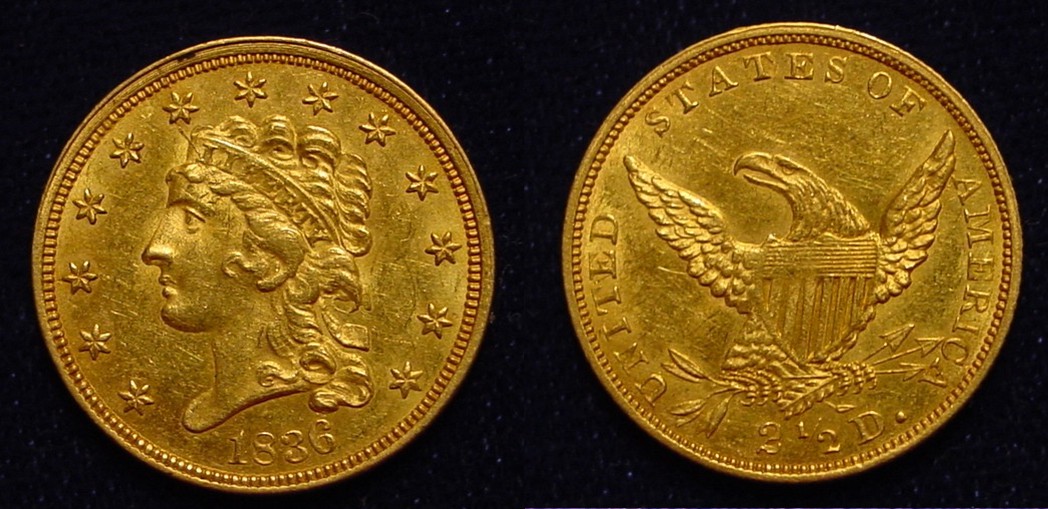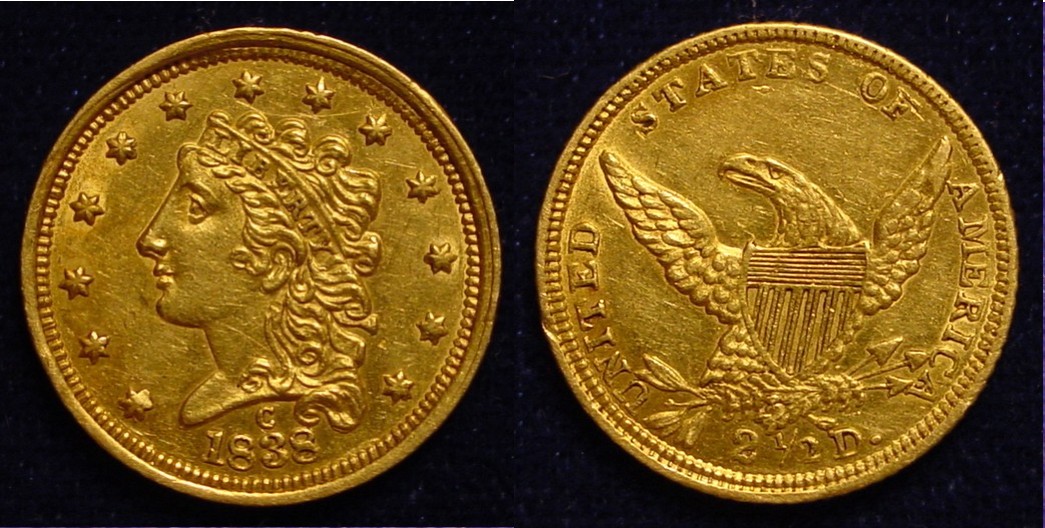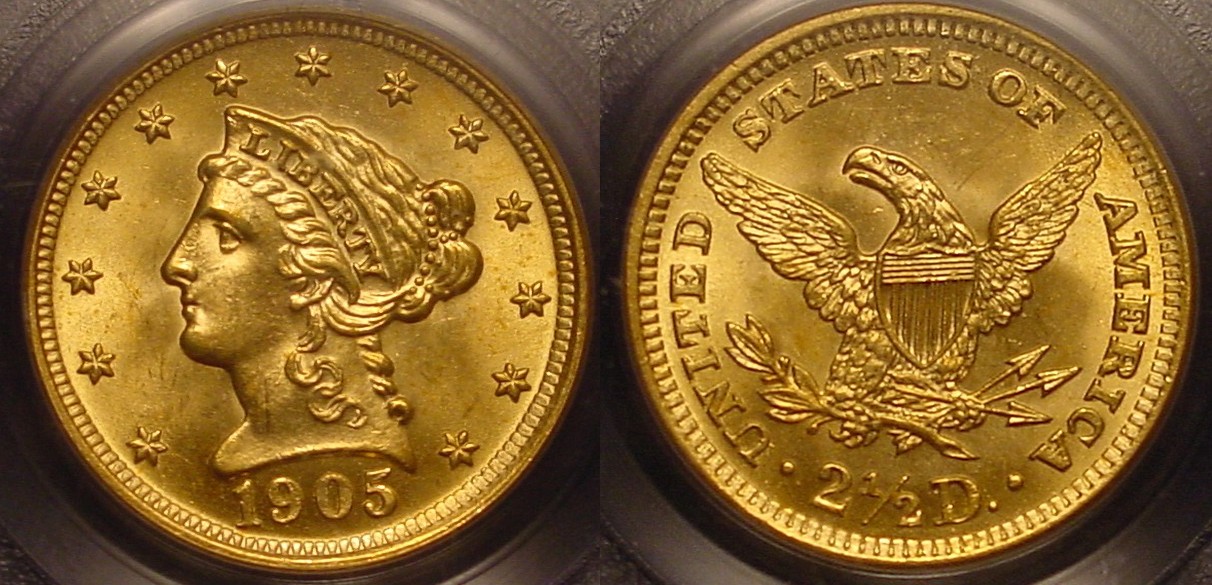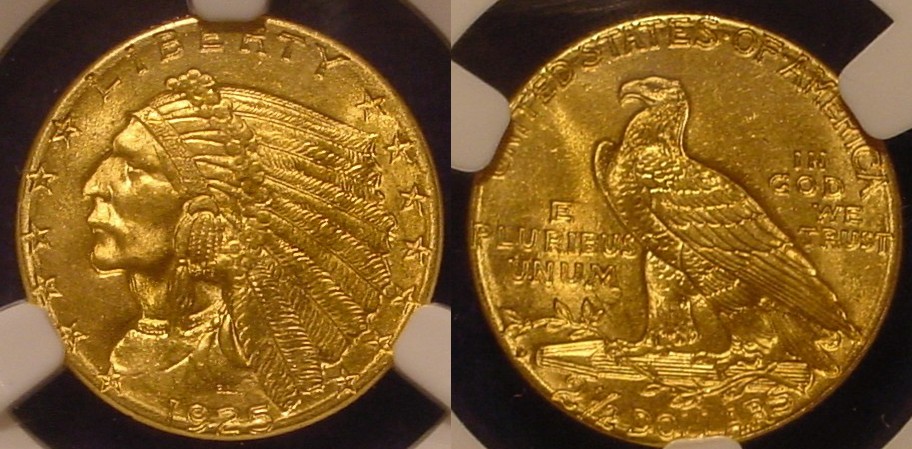Howdy, Stranger!
It looks like you're new here. If you want to get involved, click one of these buttons!
Quick Links
An Introduction to the Quarter Eagles, Part 2, August 1834 to 1929
1836 Quarter Eagle, now housed in a PCGS MS-62 holder.
Classic Head, 1834 - 1839
By 1834, the United States gold coins were in the doldrums. The melt value of the coins exceeded their face value, and the coins were seldom seen in circulation. Change was in the wind, however.
Andrew Jackson had been elected to a second term as President, and he was posed to enact his version of monetary reform. Jackson was a hard money man who disliked banks and the paper money they issued. He believed that he could bring economic prosperity and stability to farmers and the working classes if the Federal Government issued large numbers of low denomination gold coins for them to use.
The Coinage Act of 1834 reduced the weight of U.S. gold coins to a gold content that was equal to or slightly below their melt value. The new gold pieces went into to circulation and stayed there. The Classic Head two and a half and five dollar gold coins are very scarce in strictly Mint State condition, but they are fairly common in the VF and EF grades.
Chief mint engraver, William Kneass faced a challenge. He needed to redesign the new coins so that they could be readily differentiated from the old ones. One proposal was to place "August 1834" on the pieces because that was date that the mint began to issue to new, lighter coins. Ultimately the Kneass decided to omit the motto "E Pluribus Unum" from the reverse of the new coin and removed Ms. Liberty’s cap, leaving her with a bare head. These were the only major changes that he made for his Classic Head Design although he and his successor, Christian Gobrecht, tinkered with it in subsequent years.
The Classic Head Quarter Eagles were issued from 1834 until 1839. In 1838 the Charlotte Mint issued its first Classic Head $2.50 piece. The Dahlonega and New Orleans Mints followed suit in 1839.
1838-C Quarter Eagle, now housed in a PCGS AU-55 holder.
1805 Quarter Eagle, PCGS MS-63
Liberty Head, 1840 - 1907
Christian Gobrecht, who took over as the chief engraver after William Kneass suffered a stroke, brought his Liberty Head design to the quarter eagle in 1840. The coin featured a portrait of Ms. Liberty wearing a crown with the word "LIBERTY" across its side. There were only minor changes to the eagle on the reverse.
The Liberty Quarter Eagle would be one of the longest running coinage designs in the American series. Mint System issued it from 1840 to 1907. During that almost 70 year period, at least one U.S. mint issued quarter eagles although some of the annual mintages were very small. The most famous rarities are the 1841 quarter eagle, which was known among collectors of previous generations as "the little princess," and the 1854-S which is represented by a surviving population of just 11 pieces. The 1848 CAL. quarter is a famous rarity that was made from the first shipment of California gold that arrived to the East Coast of the United States. The total mintage of quarter eagles was only 640 pieces in 1881 and 800 pieces in 1885. This is only a small sample of the total number of rarities that exist in the series.
1925-D Quarter Eagle, NGC MS-65
Indian, 1908 - 1929
By 1908 President Theodore Roosevelt was in the midst of his U.S. coin design revolution. The Philadelphia Mint had produced the magnificent 1907 High Relief $20 gold piece, but Roosevelt had had to accept the fact that the design would have to be issued in lower relief to be practical. A preliminary decision had been made to adapt the St. Gaudens' Standing Liberty design to the $2.50 and $5.00 gold coins, and Charles Barber was wrestling the problems associated with that.
While the mint personnel were mulling over the design issue, Boston aristocrat, William Sturgis Bigelow, presented a proposal to his friend, President Roosevelt. Bigelow was a medical doctor, but he was far more interested in art, most especially works from Japan and the orient. He was aware of the difficulties that President Roosevelt had had with his experiments in high relief coinage and had a proposal that might solve the president's problems. Bigelow's concept was to design a coin where the relief was intaglio or recessed below the fields of the piece.
Bigelow engaged the services of artist Bela Lyon Pratt to develop a design. Pratt had been a student of St. Gaudens and had studied at the Ecole des Beaux-Arts in Paris. By this time Pratt had become a very successful artist on his own with many public art projects that bore his name. Bigelow offered Pratt $300 to devise a design and sculpt a model of his coinage proposal.
The Pratt design featured a bust of realistic American Indian wearing a war bonnet. Bigelow knew that the Native American design would get President Roosevelt onboard with the project very quickly. Bigelow became the liaison between Charles Barber at the Mint and Bela Pratt. Pratt had little or no contact with the mint personnel, which was an odd arrangement to say the least.
Ultimately Pratt was paid a total of $600 to produce designs for both sides of the coin. Pratt's reverse was similar to the standing eagle that appeared on the reverse of the $10 Indian coin although its legs and neck were shorter. Pratt also moved the motto "E Pluribus Unum" and added "In God we trust."
Pratt's original designs were represented by ten $2.50 and ten $5.00 gold pattern coins, that were made at the Philadelphia Mint and given to Bigelow to show to the president. These pieces did not carry the designer’s initials, “BLP,” which differentiated them from the regular issue coins. Bigelow kept one half eagle and returned the other nineteen pieces to the mint where they were melted. Not even one piece was saved to be placed in the Mint Cabinet Collection. Today the whereabouts of the one piece that Bigelow retained are unknown.
Once the decision was made to go ahead with Pratt's design, it was turned over to Charles Barber for his finishing touches. According to Pratt, Barber "butchered" his work. The artist was very displeased with the ultimate design, especially on the $5.00 piece. His objections centered upon the stars on the obverse which were placed too close to the rim of the coin, and the treatment of the Indian's headdress.
Pratt was also disappointed by the fact that he received only $600 for his work. All of the other artists of the period received more than double that amount. To add insult to injury, the coins were known for some years as the "Bigelow - Pratt design" despite the fact that Bigelow had had nothing to do with the artwork. The Indian $2.50 and $5.00 gold coins went into circulation at the end of 1908, just in time for the Christmas season. A fair number of the coins were given as Christmas gifts.
The press reception for coin was mixed. Some said the Indian looked tired, underfed and "out of luck." The eagle was said to be a golden eagle which was often representative of despotic regimes. Even more ludicrous were the claims that the recessed areas of the coin's design would be dirt traps that would spread diseases throughout the country.
Despite the chilly reception, the two coins were issued, with some breaks, from 1908 until 1929. All gold coinage was suspended during World War I. Quarter eagle production resumed at the Denver Mint in 1925 and would continue at the Philadelphia Mint until 1929. That year the Stock Market Crash signaled the beginning of the Great Depression which greatly curtailed the need for new $2.50 and $5.00 gold coins. Any chance that the $2.50 and $5.00 gold series would resume ended with Franklin Roosevelt's Gold Surrender order which formally ended the use of gold coinage within the United States.
Today the $2.50 Indian gold set is the only collection of the "old" U.S. gold coinage that many modern collectors can hope to complete. There are 15 coins in the set, and the only piece that is expensive in all grades is the 1911-D. That coin is always available for a price although in recent years that number has reached several thousand dollars in EF and AU.
During the 133 years that The United States Mint System issued the quarter eagle, the total mintage was 20,210,149 pieces. That is not many coins when you consider the modern mint can make a similar number of pieces in an hour. Many dates in the series are scarce, but collector interest has always been limited. Clearly if you are a collector who would like to have some pieces that few other collectors can ever own, the quarter eagle series offers you many opportunities.






Comments
I highly recommend the book "United States Classic Gold Coins of 1834-1839" by Daryl Haynor. Great color photos of every coin in both the Quarter Eagle and Half Eagle series (350 pages). A must have reference book for people interested in either of these series.